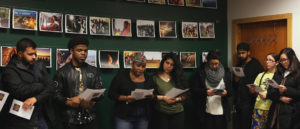Monday evening was the official opening for the new Mosaic Multicultural Center, located in the area previously known as “The Hub”.
The story of the Multicultural Center is one of quick action and decision. The idea for the center had been around for some time, but really picked up steam after the Students of Color Leadership Summit, which Houghton students attended in the fall of 2016. According to student body president Sergio Mata, the center only started to become a reality in the spring of 2017, when President Mullen called together a task force to address various racial issues on campus. Issues they considered included the hiring diverse faculty, a bias response policy, and a statement of diversity. The center was devised by the task force, and it quickly went from a dream to a reality. “I’m surprised by the quick response of the administration in making this a high priority,” Mata said. “I think we’re moving in the right direction… we are catching up to where other institutions, especially Christian colleges, are.”
 Marc Smithers, the Assistant Dean of Students for Residence Life and Programs, said this is what the Center is supposed to be. He explained that when the task force was designing the Mosaic Center, “we looked at what places like Calvin or Alfred State had on their campuses and modeled after that.” In addition to looking at other colleges, the task force collaborated with a lot of people around campus as well. Sergio Mata ‘19, Khadeeja Smith ‘18, and Kristen Sanasith, Coordinator for Tutoring and Testing Services, were all instrumental in the process of making the center happen.
Marc Smithers, the Assistant Dean of Students for Residence Life and Programs, said this is what the Center is supposed to be. He explained that when the task force was designing the Mosaic Center, “we looked at what places like Calvin or Alfred State had on their campuses and modeled after that.” In addition to looking at other colleges, the task force collaborated with a lot of people around campus as well. Sergio Mata ‘19, Khadeeja Smith ‘18, and Kristen Sanasith, Coordinator for Tutoring and Testing Services, were all instrumental in the process of making the center happen.
Another person who helped out with making the center a reality is Shaphan Hestick ‘19, the Executive officer of Diversity and Inclusion. In his words, his position is to “act as a bridge between students of color and the administration,” meaning that his perspective was key in the formation of the Mosaic Center. Smithers and Sanasith would come to him with questions about things as seemingly trivial as the title of the center, the furniture choices, and the color scheme. Their goal was to make the Mosaic Center more inclusive, and Hestick was more than happy to give his opinion. “The administration wanted it to be a discipleship center, and have student life be involved in that, but I recommended that wasn’t a good idea,” he says. “I thought that students not involved in spiritual life might feel excluded.”
As far as what is going into the Center, Sanasith was very excited about the prospects. She said she “took into consideration the attributes and characteristics of what defines home for many of our diverse students.” She explained how all of her interior design choices reflect her attempts to make a warm and inviting atmosphere for the students who will be using the center. “I wanted to achieve a balance between relaxation and motivation for these students.” Making this space comfortable for students was Sanasith’s top priority, and she was integral to the design and execution of the center.
Now, the Mosaic Multicultural Center is in its last stages of production, and everyone involved in the project is optimistic about its impact. The purpose of the Center, according to its mission statement, is “to be the campus focal point for deep conversations, international connections and rich learning centered on the diverse experiences of the members of our community.” Hestick is optimistic that the Center will fulfill this function, specifically by providing a space for international students or students of color to be able to come and meet or relax without facing any pressure from outside influences.
“We are hoping the center will be a part of the emotional gratification of students of color on campus,” he said, “where we dignify a space for them to feel like what they’re used to.” From an administrative standpoint, Smithers hopes the Center will be a way for the campus to grow in terms of racial reconciliation. He hopes that through the Mosaic Center, Houghton can incorporate “effective and dynamic programming and education,” which in turn will “bring about greater cultural competency among students, staff, and faculty.”
The newly opened center is indicative of the work Houghton has done in recent years, and the work still left to do. Mata explained when he commented on the name of the center itself: “The name represents what it is – a bunch of us coming together, a mosaic of different pieces coming together to make a larger picture.”
